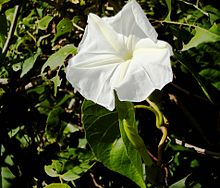bio.wikisort.org - Plant
Ipomoea violacea is a perennial species of Ipomoea that occurs throughout the world with the exception of the European continent. It is most commonly called beach moonflower or sea moonflower as the flowers open at night.[1]
Description
The corolla of the flower of Ipomoea violacea is white, distinguishing this species from Ipomoea tricolor, commonly called Heavenly Blue. It is sometimes mistaken for the cultivar Pearly Gates, the corolla of which is also white, probably because of its misleading Latin binomial name, Ipomoea violacea, "violacea" meaning purple.[2]
Comparative taxonomies
A comparison of the taxonomy of the two plants shows that they belong to different Subgenera, consequently, Ipomoea violacea should not be used as a synonym for Ipomoea tricolor. In exceptional cases where Ipomoea violacea has to be used as a synonym of Ipomoea tricolor, one must specify the incorrect usage by using the abbreviation 'Auct.' for Auctorum.[3]
Ipomoea violacea:[3]
- Genus: Ipomoea
- Subgenus: Eriospermum
- Section: Erpipomoea
Ipomoea tricolor:[4]
- Genus: Ipomoea
- Subgenus: Quamoclit
- Section: Tricolor
LSA presence
The Native Americans of Mexico are known to have long used the seeds of species of Ipomoea for preparing psychedelic infusions; several scientific studies indicate they contain several ergoline alkaloids with effects somewhat similar to, but weaker than, those of LSD[5][6] It is possible that some of these studies may have mistaken Ipomoea violacea for Ipomoea tricolor, e.g., works published in the scientific journal Phytochemistry[7] and quoted by the Sociedade Brasileira de Farmacognosia,[8] which purportedly showed the presence of Ergine, also known as d-lysergic acid amide (LSA) in Ipomoea violacea.
The discoverer of LSD, Albert Hofmann, himself misleads the reader in his book Plants of the Gods: Their Sacred, Healing, and Hallucinogenic Powers by describing Ipomoea tricolor (the flower shown in the book is clearly one of Ipomoea tricolor, heavenly blue), but is labeled as Ipomoea violacea. As specified in the upper section of its description, Ipomoea violacea's corolla is white only. Because studies on the presence of LSA in Ipomoea violacea do not specify the complete taxonomy of the plant, it cannot be certain that Ipomoea violacea contains d-lysergic acid amide. As of 2016, only Ipomoea tricolor is proved to contain LSA in its seeds.
References
- "Ipomoea violacea". Germplasm Resources Information Network (GRIN). Agricultural Research Service (ARS), United States Department of Agriculture (USDA). Retrieved 18 December 2017.
- "Herbarium musei parisiensis". Archived from the original on 2016-03-03. Retrieved 2012-09-01.
- "Ipomoea violacea auct". Germplasm Resources Information Network (GRIN). Agricultural Research Service (ARS), United States Department of Agriculture (USDA). Retrieved 18 December 2017.
- "Ipomoea tricolor". Germplasm Resources Information Network (GRIN). Agricultural Research Service (ARS), United States Department of Agriculture (USDA). Retrieved 18 December 2017.
- "Extraction and Identification of Clavine and Lysergic Acid Alkaloids from Morning Glories". Ohio Journal of Science. 75 (4). July 1975. hdl:1811/22310.
- David S. Seigler Plant secondary metabolism. Springer, 1998, ISBN 0-412-01981-7 p. 655.
- Phytochemistry. Volume 57, Issue 5, July 2001, pp. 721–72.
- Meira, Marilena; Silva, Eliezer Pereira da; David, Jorge M; David, Juceni P (June 2012). "Review of the genus Ipomoea: traditional uses, chemistry and biological activities". Revista Brasileira de Farmacognosia. 22 (3): 682. doi:10.1590/S0102-695X2012005000025. ISSN 0102-695X.
External links
- Dressler, S.; Schmidt, M. & Zizka, G. (2014). "Ipomoea violacea". African plants – a Photo Guide. Frankfurt/Main: Forschungsinstitut Senckenberg.
На других языках
[de] Ipomoea violacea
Die Ipomoea violacea ist eine Pflanzenart aus der Gattung der Prunkwinden (Ipomoea) innerhalb der Familie der Windengewächse (Convolvulaceae). Sie kommt vor allem in den Küstenregionen der Tropen vor. Am bekanntesten ist sie unter den englischsprachigen Trivialnamen "Beach Moonflower" oder "Sea Moonflower", da sich die Blüten in der Nacht öffnen, aber sehr oft werden andere Arten unter diesem Trivialnamen kultiviert, vor allem die sehr beliebte himmelblau blühende Ipomoea tricolor. Ipomoea violacea blüht jedoch weiß und wird kaum als Zierpflanze verwendet.- [en] Ipomoea violacea
[es] Ipomoea violacea
Ipomoea violacea, conocida como gloria de la mañana es una especie que pertenece a la familia de las Convolvuláceas. Procede principalmente de Norteamérica -en especial de la zona de México- y de Centroamérica. Se ha naturalizado en todos los países tropicales. Ha sido introducida en Europa como ornamental.[ru] Ipomoea violacea
Ipomoea violacea (лат.) — растение рода Ипомея семейства Вьюнковые (Convolvulaceae). Семена некоторых разновидностей Ipomoea violacea содержат психоактивные вещества и традиционно используются коренным населением Америки в магических ритуалах (как правило, в предсказаниях будущего).Другой контент может иметь иную лицензию. Перед использованием материалов сайта WikiSort.org внимательно изучите правила лицензирования конкретных элементов наполнения сайта.
WikiSort.org - проект по пересортировке и дополнению контента Википедии
